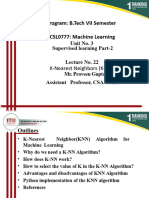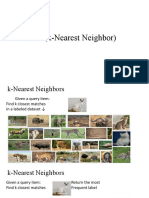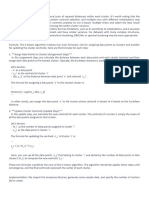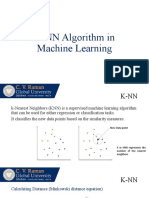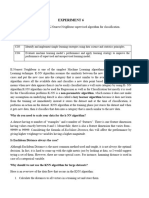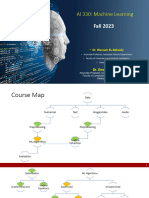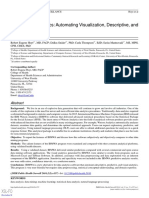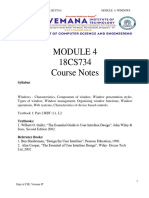Page 1 of 11
Home Whiteboard AI Assistant Online Compilers Jobs Tools Art
SQL HTML CSS Javascript Python Java C C++ PHP Scala C#
K-Nearest Neighbors (KNN) in Machine
Learning
K-Nearest Neighbors (KNN) Algorithm
K-nearest neighbors (KNN) algorithm is a type of supervised ML algorithm which can be
used for both classification as well as regression predictive problems. However, it is
mainly used for classification predictive problems in industry. The main idea behind KNN
is to find the k-nearest data points to a given test data point and use these nearest
neighbors to make a prediction. The value of k is a hyperparameter that needs to be
tuned, and it represents the number of neighbors to consider.
For classification problems, the KNN algorithm assigns the test data point to the class
that appears most frequently among the k-nearest neighbors. In other words, the class
with the highest number of neighbors is the predicted class.
For regression problems, the KNN algorithm assigns the test data point the average of
the k-nearest neighbors' values.
The distance metric used to measure the similarity between two data points is an
essential factor that affects the KNN algorithm's performance. The most commonly used
distance metrics are Euclidean distance, Manhattan distance, and Minkowski distance.
The following two properties would define KNN well −
Lazy learning algorithm − KNN is a lazy learning algorithm because it does not
have a specialized training phase and uses all the data for training while
classification.
Non-parametric learning algorithm − KNN is also a non-parametric learning
algorithm because it doesn't assume anything about the underlying data.
https://www.tutorialspoint.com/machine_learning/machine_learning_knn_nearest_neighbors.htm 1/11
� Page 2 of 11
How Does K-Nearest Neighbors Algorithm Work?
K-nearest neighbors (KNN) algorithm uses 'feature similarity' to predict the values of
new datapoints which further means that the new data point will be assigned a value
based on how closely it matches the points in the training set. We can understand its
working with the help of following steps −
Step 1 − For implementing any algorithm, we need dataset. So during the first
step of KNN, we must load the training as well as test data.
Step 2 − Next, we need to choose the value of K i.e. the nearest data points. K
can be any integer.
Step 3 − For each point in the test data do the following −
3.1 − Calculate the distance between test data and each row of training data
with the help of any of the method namely: Euclidean, Manhattan or Hamming
distance. The most commonly used method to calculate distance is Euclidean.
3.2 − Now, based on the distance value, sort them in ascending order.
3.3 − Next, it will choose the top K rows from the sorted array.
3.4 − Now, it will assign a class to the test point based on most frequent class of
these rows.
Step 4 − End
Example
The following is an example to understand the concept of K and working of KNN
algorithm −
Suppose we have a dataset which can be plotted as follows −
https://www.tutorialspoint.com/machine_learning/machine_learning_knn_nearest_neighbors.htm 2/11
� Page 3 of 11
Now, we need to classify new data point with black dot (at point 60,60) into blue or red
class. We are assuming K = 3 i.e. it would find three nearest data points. It is shown in
the next diagram −
We can see in the above diagram the three nearest neighbors of the data point with
black dot. Among those three, two of them lies in Red class hence the black dot will also
be assigned in red class.
https://www.tutorialspoint.com/machine_learning/machine_learning_knn_nearest_neighbors.htm 3/11
� Page 4 of 11
Building a K Nearest Neighbors Model
We can follow the below steps to build a KNN model −
Load the data − The first step is to load the dataset into memory. This can be
done using various libraries such as pandas or numpy.
Split the data − The next step is to split the data into training and test sets. The
training set is used to train the KNN algorithm, while the test set is used to evaluate
its performance.
Normalize the data − Before training the KNN algorithm, it is essential to
normalize the data to ensure that each feature contributes equally to the distance
metric calculation.
Calculate distances − Once the data is normalized, the KNN algorithm calculates
the distances between the test data point and each data point in the training set.
Select k-nearest neighbors − The KNN algorithm selects the k-nearest neighbors
based on the distances calculated in the previous step.
Make a prediction − For classification problems, the KNN algorithm assigns the
test data point to the class that appears most frequently among the k-nearest
neighbors. For regression problems, the KNN algorithm assigns the test data point
the average of the k-nearest neighbors' values.
Evaluate performance − Finally, the KNN algorithm's performance is evaluated
using various metrics such as accuracy, precision, recall, and F1-score.
Implementation of KNN Algorithm in Python
As we know K-nearest neighbors (KNN) algorithm can be used for both classification as
well as regression. The following are the recipes in Python to use KNN as classifier as
well as regressor −
KNN as Classifier
First, start with importing necessary python packages −
import numpy as np
import matplotlib.pyplot as plt
import pandas as pd
Next, download the iris dataset from its weblink as follows −
path = "https://archive.ics.uci.edu/ml/machine-learning-
https://www.tutorialspoint.com/machine_learning/machine_learning_knn_nearest_neighbors.htm 4/11
� Page 5 of 11
databases/iris/iris.data"
Next, we need to assign column names to the dataset as follows −
headernames = ['sepal-length', 'sepal-width', 'petal-length', 'petal-width',
'Class']
Now, we need to read dataset to pandas dataframe as follows −
dataset = pd.read_csv(path, names=headernames)
dataset.head()
slno. sepal-length sepal-width petal-length petal-width Class
0 5.1 3.5 1.4 0.2 Iris-setosa
1 4.9 3.0 1.4 0.2 Iris-setosa
2 4.7 3.2 1.3 0.2 Iris-setosa
3 4.6 3.1 1.5 0.2 Iris-setosa
4 5.0 3.6 1.4 0.2 Iris-setosa
Data Preprocessing will be done with the help of following script lines −
X = dataset.iloc[:, :-1].values
y = dataset.iloc[:, 4].values
Next, we will divide the data into train and test split. Following code will split the dataset
into 60% training data and 40% of testing data −
from sklearn.model_selection import train_test_split
X_train, X_test, y_train, y_test = train_test_split(X, y, test_size=0.40)
Next, data scaling will be done as follows −
from sklearn.preprocessing import StandardScaler
scaler = StandardScaler()
scaler.fit(X_train)
https://www.tutorialspoint.com/machine_learning/machine_learning_knn_nearest_neighbors.htm 5/11
� Page 6 of 11
X_train = scaler.transform(X_train)
X_test = scaler.transform(X_test)
Next, train the model with the help of KNeighborsClassifier class of sklearn as follows −
from sklearn.neighbors import KNeighborsClassifier
classifier = KNeighborsClassifier(n_neighbors=8)
classifier.fit(X_train, y_train)
At last we need to make prediction. It can be done with the help of following script −
y_pred = classifier.predict(X_test)
Next, print the results as follows −
from sklearn.metrics import classification_report, confusion_matrix,
accuracy_score
result = confusion_matrix(y_test, y_pred)
print("Confusion Matrix:")
print(result)
result1 = classification_report(y_test, y_pred)
print("Classification Report:",)
print (result1)
result2 = accuracy_score(y_test,y_pred)
print("Accuracy:",result2)
Output
Confusion Matrix:
[[21 0 0]
[ 0 16 0]
[ 0 7 16]]
Classification Report:
precision recall f1-score support
Iris-setosa 1.00 1.00 1.00 21
Iris-versicolor 0.70 1.00 0.82 16
Iris-virginica 1.00 0.70 0.82 23
micro avg 0.88 0.88 0.88 60
macro avg 0.90 0.90 0.88 60
https://www.tutorialspoint.com/machine_learning/machine_learning_knn_nearest_neighbors.htm 6/11
� Page 7 of 11
weighted avg 0.92 0.88 0.88 60
Accuracy: 0.8833333333333333
KNN as Regressor
First, start with importing necessary Python packages −
import numpy as np
import pandas as pd
Next, download the iris dataset from its weblink as follows −
path = "https://archive.ics.uci.edu/ml/machine-learning-
databases/iris/iris.data"
Next, we need to assign column names to the dataset as follows −
headernames = ['sepal-length', 'sepal-width', 'petal-length', 'petal-width',
'Class']
Now, we need to read dataset to pandas dataframe as follows −
data = pd.read_csv(url, names=headernames)
array = data.values
X = array[:,:2]
Y = array[:,2]
data.shape
output:(150, 5)
Next, import KNeighborsRegressor from sklearn to fit the model −
from sklearn.neighbors import KNeighborsRegressor
knnr = KNeighborsRegressor(n_neighbors=10)
knnr.fit(X, y)
At last, we can find the MSE as follows −
https://www.tutorialspoint.com/machine_learning/machine_learning_knn_nearest_neighbors.htm 7/11
� Page 8 of 11
print ("The MSE is:",format(np.power(y-knnr.predict(X),2).mean()))
Output
The MSE is: 0.12226666666666669
Pros and Cons of KNN
Pros
It is very simple algorithm to understand and interpret.
It is very useful for nonlinear data because there is no assumption about data in
this algorithm.
It is a versatile algorithm as we can use it for classification as well as regression.
It has relatively high accuracy but there are much better supervised learning
models than KNN.
Cons
It is computationally a bit expensive algorithm because it stores all the training
data.
High memory storage required as compared to other supervised learning
algorithms.
Prediction is slow in case of big N.
It is very sensitive to the scale of data as well as irrelevant features.
Applications of KNN
The following are some of the areas in which KNN can be applied successfully −
Banking System
Chapters
KNN can Categories
be used in banking system to predict weather an individual is fit for loan
approval? Does that individual have the characteristics similar to the defaulters one?
Calculating Credit Ratings
https://www.tutorialspoint.com/machine_learning/machine_learning_knn_nearest_neighbors.htm 8/11
� Page 9 of 11
KNN algorithms can be used to find an individual's credit rating by comparing with the
persons having similar traits.
Politics
With the help of KNN algorithms, we can classify a potential voter into various classes
like "Will Vote", "Will not Vote", "Will Vote to Party 'Congress', "Will Vote to Party 'BJP'.
Other areas in which KNN algorithm can be used are Speech Recognition, Handwriting
Detection, Image Recognition and Video Recognition.
TOP TUTORIALS
Python Tutorial
Java Tutorial
C++ Tutorial
C Programming Tutorial
C# Tutorial
PHP Tutorial
R Tutorial
HTML Tutorial
CSS Tutorial
JavaScript Tutorial
SQL Tutorial
TRENDING TECHNOLOGIES
Cloud Computing Tutorial
Amazon Web Services Tutorial
Microsoft Azure Tutorial
Git Tutorial
Ethical Hacking Tutorial
Docker Tutorial
Kubernetes Tutorial
DSA Tutorial
Spring Boot Tutorial
SDLC Tutorial
Unix Tutorial
https://www.tutorialspoint.com/machine_learning/machine_learning_knn_nearest_neighbors.htm 9/11
� Page 10 of 11
CERTIFICATIONS
Business Analytics Certification
Java & Spring Boot Advanced Certification
Data Science Advanced Certification
Cloud Computing And DevOps
Advanced Certification In Business Analytics
Artificial Intelligence And Machine Learning
DevOps Certification
Game Development Certification
Front-End Developer Certification
AWS Certification Training
Python Programming Certification
COMPILERS & EDITORS
Online Java Compiler
Online Python Compiler
Online Go Compiler
Online C Compiler
Online C++ Compiler
Online C# Compiler
Online PHP Compiler
Online MATLAB Compiler
Online Bash Compiler
Online SQL Compiler
Online Html Editor
ABOUT US | OUR TEAM | CAREERS | JOBS | CONTACT US | TERMS OF USE |
PRIVACY POLICY | REFUND POLICY | COOKIES POLICY | FAQ'S
https://www.tutorialspoint.com/machine_learning/machine_learning_knn_nearest_neighbors.htm 10/11
� Page 11 of 11
Tutorials Point is a leading Ed Tech company striving to provide the best learning material on
technical and non-technical subjects.
© Copyright 2025. All Rights Reserved.
https://www.tutorialspoint.com/machine_learning/machine_learning_knn_nearest_neighbors.htm 11/11
